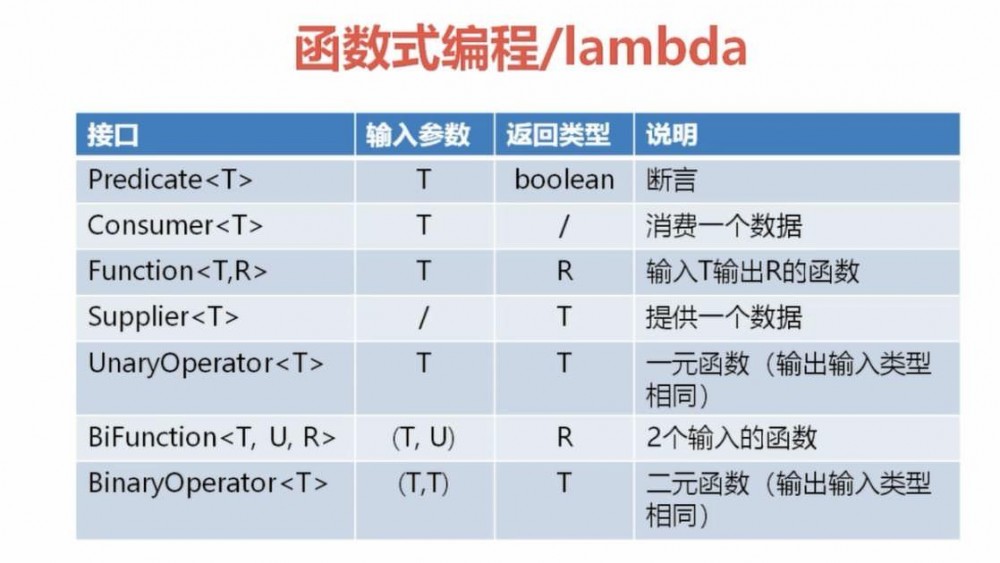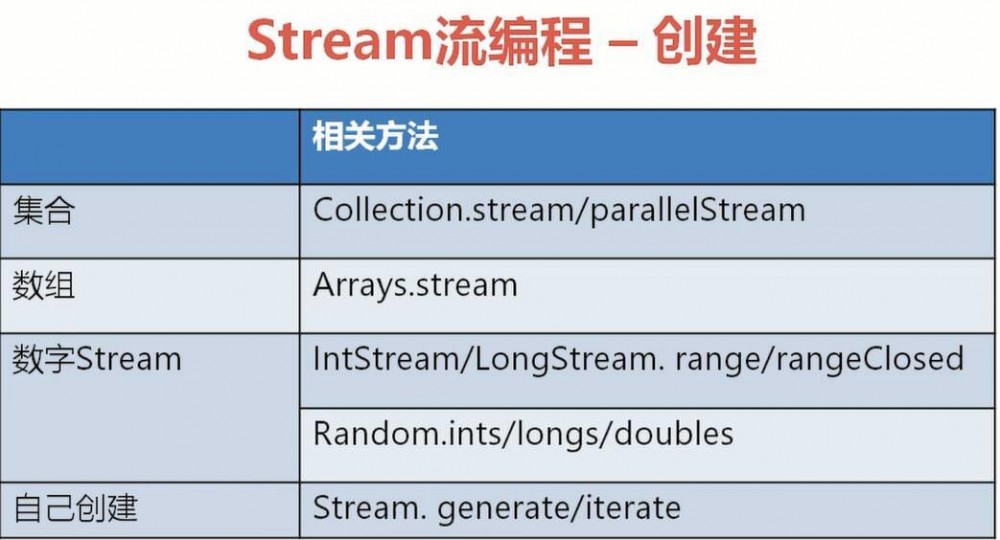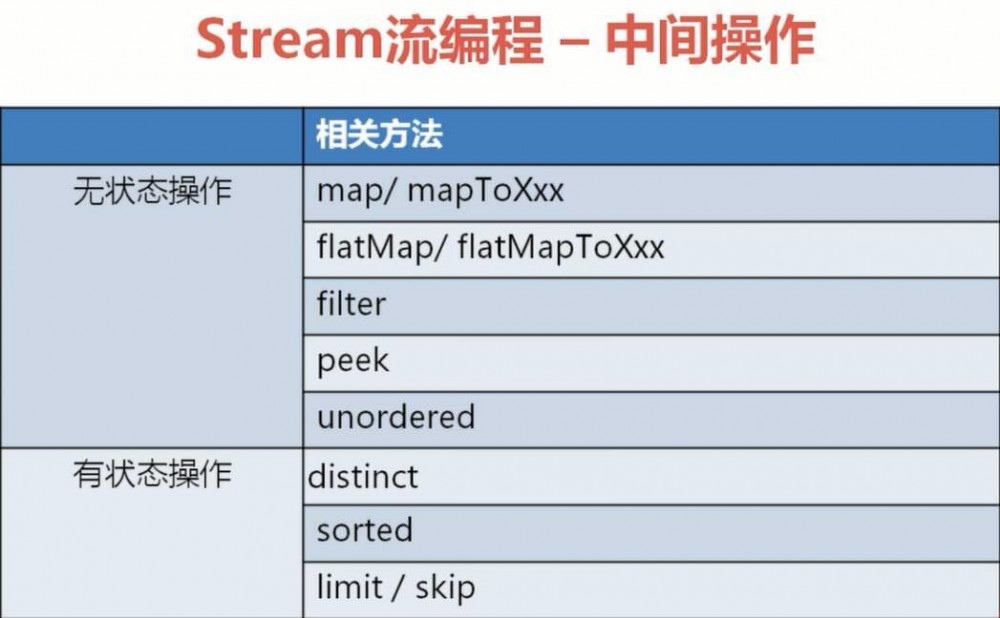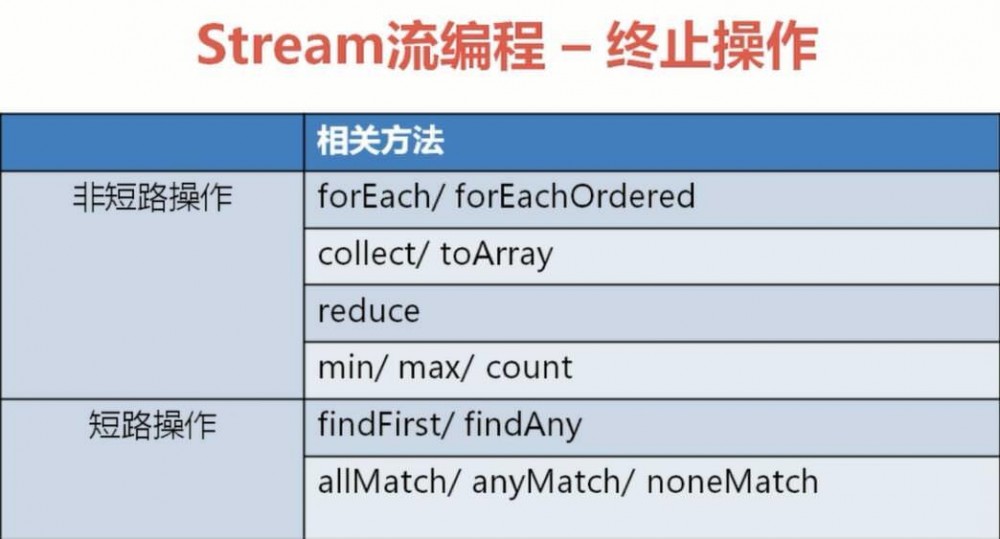Java8的函数式编程
函数式编程:是一种如何搭建应用程序的方法论。(lambda表达式+Stream流的思想)
命令式编程和函数式编程的异同点:
-
命令式编程关注怎么样做,而函数式编程中关注做什么
import java.util.stream.IntStream; public class MinDemo { public static void main(String[] args) { int[] nums = {35,65,-55,100,-676,95}; //命令式编程(具体怎么做) int min = Integer.MAX_VALUE; for (int i : nums) { if(i < min) { min = i; } } System.out.println(min); //jdk8的函数式编,多线程并行处理(需要做什么) int min2 = IntStream.of(nums).parallel().min().getAsInt(); System.out.println(min2); } } 复制代码 -
函数式编程让代码更加可读
public class ThreadDemo { public static void main(String[] args) { //命令式编程中的写法 Object target = new Runnable() { @Override public void run() { System.out.println("新建了一个线程"); } }; new Thread((Runnable) target).start(); // jdk8 lambda函数式编程中的写法 Object target2 = (Runnable)() -> System.out.println("新建了一个线程"); Runnable target3 = () -> System.out.println("新建了一个线程"); System.out.println(target2 == target3); // false new Thread((Runnable) target2).start(); } } 复制代码
lambda表达式中返回一个接口需要满足的条件:
-
该接口中只能有一个方法
-
需要在接口上加上@FunctionalInterface注解(编译器的校验)
-
JDK8中在接口中增加的默认的方法
package lambda; import java.text.DecimalFormat; import java.util.Arrays; import java.util.function.Function; @FunctionalInterface interface Interface1 { int doubleNum(int i); default int add(int x, int y) { return x + y; } static int sub(int x, int y) { return x - y; } } @FunctionalInterface interface Interface2 { int doubleNum(int i); default int add(int x, int y) { return x + y; } } @FunctionalInterface interface Interface3 extends Interface2, Interface1 { @Override default int add(int x, int y) { return Interface1.super.add(x, y); } } public strictfp class LambdaDemo1 { public static void main(String[] args) { Interface1 i1 = (i) -> i * 2; Interface1.sub(10, 3); System.out.println(i1.add(3, 7)); System.out.println(i1.doubleNum(20)); Interface1 i2 = i -> i * 2; Interface1 i3 = (int i) -> i * 2; Interface1 i4 = (int i) -> { System.out.println("-----"); return i * 2; }; } } 复制代码
JDK8自带的函数接口的链式操作:
class Money {
private final int money;
public MyMoney(int money) {
this.money = money;
}
public void printMoney(Function<Integer, String> moneyFormat) {
System.out.println("我的存款" + moneyFormat.apply(this.money));
}
}
public class MoneyDemo {
public static void main(String[] args) {
Money me = new Money(99999999);
Function<Integer, String> moneyFormat = i -> new DecimalFormat("#,###")
.format(i);
// 函数接口的链式操作
me.printMoney(moneyFormat.andThen(s -> "人们币" + s));
}
}
复制代码
其他JdK8自带的接口函数

import java.util.function.Consumer;
import java.util.function.IntPredicate;
public class FunctionDemo {
public static void main(String[] args) {
// 断言函数接口
IntPredicate predicate = i -> i > 0;
System.out.println(predicate.test(-9));//false
// IntConsumer
// 消费函数接口
Consumer<String> consumer = s -> System.out.println(s);
consumer.accept("输入的数据");//输入的数据
}
}
复制代码
Java8中lamdba中方法的引用:
import java.util.ArrayList;
import java.util.List;
import java.util.function.Consumer;
import java.util.function.IntUnaryOperator;
class Dog {
private String name = "哮天犬";
/**
* 默认10斤狗粮
*/
private int food = 10;
public Dog() {
}
/**
* 带参数的构造函数
*
* @param name
*/
public Dog(String name) {
this.name = name;
}
/**
* 狗叫,静态方法
*
* @param dog
*/
public static void bark(Dog dog) {
System.out.println(dog + "叫了");
}
/**
* 吃狗粮 JDK
*
* 默认会把当前实例传入到非静态方法,参数名为this,位置是第一个;
*
* @param num
* @return 还剩下多少斤
*/
public int eat(int num) {
System.out.println("吃了" + num + "斤狗粮");
this.food -= num;
return this.food;
}
@Override
public String toString() {
return this.name;
}
}
public class MethodRefrenceDemo {
public static void main(String[] args) {
Dog dog = new Dog();
dog.eat(3);
// 方法引用
Consumer<String> consumer = System.out::println;
consumer.accept("接受的数据");
// 静态方法的方法引用
Consumer<Dog> consumer2 = Dog::bark;
consumer2.accept(dog);
// 非静态方法,使用对象实例的方法引用
// Function<Integer, Integer> function = dog::eat;
// UnaryOperator<Integer> function = dog::eat;
IntUnaryOperator function = dog::eat;
// dog置空,不影响下面的函数执行,因为java 参数是传值
dog = null;//java中的函数是值传递不是传引用,所以不会出现空指针异常
System.out.println("还剩下" + function.applyAsInt(2) + "斤");
// 使用类名来方法引用
// BiFunction<Dog, Integer, Integer> eatFunction = Dog::eat;
// System.out.println("还剩下" + eatFunction.apply(dog, 2) + "斤");
// 构造函数的方法引用
// Supplier<Dog> supplier = Dog::new;
// System.out.println("创建了新对象:" + supplier.get());
// 带参数的构造函数的方法引用
// Function<String, Dog> function2 = Dog::new;
// System.out.println("创建了新对象:" + function2.apply("旺财"));
// 测试java变量是传值还是传引用即值传递
List<String> list = new ArrayList<>();
test(list);
System.err.println(list);
}
private static void test(List<String> list) {
list = null;
}
}
复制代码
lambda表达式中的级联表达式和函数的柯里化
import java.util.function.Function;
/**
* 级联表达式和柯里化
* 柯里化:把多个参数的函数转换为只有一个参数的函数
* 柯里化的目的:函数标准化
* 高阶函数:就是返回函数的函数
*/
public class CurryDemo {
public static void main(String[] args) {
// 实现了x+y的级联表达式
Function<Integer, Function<Integer, Integer>> fun = x -> y -> x
+ y;
System.out.println(fun.apply(2).apply(3));
Function<Integer, Function<Integer, Function<Integer, Integer>>> fun2 = x -> y -> z -> x
+ y + z;
//函数的柯里化
System.out.println(fun2.apply(2).apply(3).apply(4));
int[] nums = { 2, 3, 4 };
Function f = fun2;
//柯里化的函数的递归调用
for (int i = 0; i < nums.length; i++) {
if (f instanceof Function) {
Object obj = f.apply(nums[i]);
if (obj instanceof Function) {
f = (Function) obj;
} else {
System.out.println("调用结束:结果为" + obj);
}
}
}
}
}
复制代码
lambda底层实现原理
- 编译器会为每一个lambda表达式生成一个方法 方法名是lambda$0,1,2,3,但方法引用的表达式不会生成方法。
- 在lambda地方会产生一个invokeDynamic指令,这个指令会调用 bootstrap(引导)方法,bootstrap方法会指向自动生成的lambda$0 方法或者方法引用的方法。
- bootstrap方法使用上是调用了LambdaMetafactory.metafactory静态方法 该方法返回了CallSite(调用站点),里面包含了MethodHandle(方法句柄) 也就是最终调用的方法。
- 引导方法只会调用一次。
自动生成的方法:
1). 输入和输出和lambda一致
2). 如果没有使用this,那么就是static方法,否则就是成员方法
Stream流的创建:

public static void main(String[] args) {
List<String> list = new ArrayList<>();
// 从集合创建
list.stream();
list.parallelStream();
// 从数组创建
Arrays.stream(new int[] { 2, 3, 5 });
// 创建数字流
IntStream.of(1, 2, 3);
IntStream.rangeClosed(1, 10);
// 使用random创建一个无限流
new Random().ints().limit(10);
Random random = new Random();
// 自己产生流
Stream.generate(() -> random.nextInt()).limit(20);
}
复制代码
Stream流的中间操作:

public static void main(String[] args) {
String str = "my name is 007";
// 把每个单词的长度调用出来
Stream.of(str.split(" ")).filter(s -> s.length() > 2)
.map(s -> s.length()).forEach(System.out::println);
// flatMap A->B属性(是个集合), 最终得到所有的A元素里面的所有B属性集合
// intStream/longStream 并不是Stream的子类, 所以要进行装箱 boxed
Stream.of(str.split(" ")).flatMap(s -> s.chars().boxed())
.forEach(i -> System.out.println((char) i.intValue()));
// peek 用于debug. 是个中间操作,和 forEach 是终止操作
System.out.println("--------------peek------------");
Stream.of(str.split(" ")).peek(System.out::println)
.forEach(System.out::println);
// limit 使用, 主要用于无限流
new Random().ints().filter(i -> i > 100 && i < 1000).limit(10)
.forEach(System.out::println);
}
复制代码
Stream流的终止操作:

public static void main(String[] args) {
String str = "my name is 007";
// 使用并行流
str.chars().parallel().forEach(i -> System.out.print((char) i));
System.out.println();
// 使用 forEachOrdered 保证顺序
str.chars().parallel().forEachOrdered(i -> System.out.print((char) i));
// 收集到list
List<String> list = Stream.of(str.split(" "))
.collect(Collectors.toList());
System.out.println(list);
// 使用 reduce 拼接字符串
Optional<String> letters = Stream.of(str.split(" "))
.reduce((s1, s2) -> s1 + "|" + s2);
System.out.println(letters.orElse(""));
// 带初始化值的reduce
String reduce = Stream.of(str.split(" ")).reduce("",
(s1, s2) -> s1 + "|" + s2);
System.out.println(reduce);
// 计算所有单词总长度
Integer length = Stream.of(str.split(" ")).map(s -> s.length())
.reduce(0, (s1, s2) -> s1 + s2);
System.out.println(length);
// max 的使用
Optional<String> max = Stream.of(str.split(" "))
.max((s1, s2) -> s1.length() - s2.length());
System.out.println(max.get());
// 使用 findFirst 短路操作
OptionalInt findFirst = new Random().ints().findFirst();
System.out.println(findFirst.getAsInt());
}
复制代码
Stream中的并行流:
public static void main(String[] args) {
// 调用parallel 产生一个并行流
// IntStream.range(1, 100).parallel().peek(StreamDemo5::debug).count();
// 现在要实现一个这样的效果: 先并行,再串行
// 多次调用 parallel / sequential, 以最后一次调用为准.
// IntStream.range(1, 100)
// // 调用parallel产生并行流
// .parallel().peek(StreamDemo5::debug)
// // 调用sequential 产生串行流
// .sequential().peek(StreamDemo5::debug2)
// .count();
// 并行流使用的线程池: ForkJoinPool.commonPool
// 默认的线程数是 当前机器的cpu个数
// 使用这个属性可以修改默认的线程数
// System.setProperty("java.util.concurrent.ForkJoinPool.common.parallelism",
// "20");
// IntStream.range(1, 100).parallel().peek(StreamDemo5::debug).count();
// 使用自己的线程池, 不使用默认线程池, 防止任务被阻塞
// 线程名字 : ForkJoinPool-1
ForkJoinPool pool = new ForkJoinPool(20);
pool.submit(() -> IntStream.range(1, 100).parallel()
.peek(StreamDemo5::debug).count());
pool.shutdown();
synchronized (pool) {
try {
pool.wait();
} catch (InterruptedException e) {
e.printStackTrace();
}
}
}
public static void debug(int i) {
System.out.println(Thread.currentThread().getName() + " debug " + i);
try {
TimeUnit.SECONDS.sleep(3);
} catch (InterruptedException e) {
e.printStackTrace();
}
}
public static void debug2(int i) {
System.err.println("debug2 " + i);
try {
TimeUnit.SECONDS.sleep(3);
} catch (InterruptedException e) {
e.printStackTrace();
}
}
复制代码
lambda中的懒加载机制:在lambda中不调用终止操作,中间的所有过程是不会执行的。
import org.apache.commons.collections4.MapUtils;
/**
* 学生 对象
*/
class Student {
/**
* 姓名
*/
private String name;
/**
* 年龄
*/
private int age;
/**
* 性别
*/
private Gender gender;
/**
* 班级
*/
private Grade grade;
public Student(String name, int age, Gender gender, Grade grade) {
super();
this.name = name;
this.age = age;
this.gender = gender;
this.grade = grade;
}
public String getName() {
return name;
}
public void setName(String name) {
this.name = name;
}
public int getAge() {
return age;
}
public void setAge(int age) {
this.age = age;
}
public Grade getGrade() {
return grade;
}
public void setGrade(Grade grade) {
this.grade = grade;
}
public Gender getGender() {
return gender;
}
public void setGender(Gender gender) {
this.gender = gender;
}
@Override
public String toString() {
return "[name=" + name + ", age=" + age + ", gender=" + gender
+ ", grade=" + grade + "]";
}
}
/**
* 性别
*/
enum Gender {
MALE, FEMALE
}
/**
* 班级
*/
enum Grade {
ONE, TWO, THREE, FOUR;
}
public class CollectDemo {
public static void main(String[] args) {
// 测试数据
List<Student> students = Arrays.asList(
new Student("小明", 10, Gender.MALE, Grade.ONE),
new Student("大明", 9, Gender.MALE, Grade.THREE),
new Student("小白", 8, Gender.FEMALE, Grade.TWO),
new Student("小黑", 13, Gender.FEMALE, Grade.FOUR),
new Student("小红", 7, Gender.FEMALE, Grade.THREE),
new Student("小黄", 13, Gender.MALE, Grade.ONE),
new Student("小青", 13, Gender.FEMALE, Grade.THREE),
new Student("小紫", 9, Gender.FEMALE, Grade.TWO),
new Student("小王", 6, Gender.MALE, Grade.ONE),
new Student("小李", 6, Gender.MALE, Grade.ONE),
new Student("小马", 14, Gender.FEMALE, Grade.FOUR),
new Student("小刘", 13, Gender.MALE, Grade.FOUR));
// 得到所有学生的年龄列表
// s -> s.getAge() --> Student::getAge , 不会多生成一个类似 lambda$0这样的函数
Set<Integer> ages = students.stream().map(Student::getAge)
.collect(Collectors.toCollection(TreeSet::new));
System.out.println("所有学生的年龄:" + ages);
// 统计汇总信息
IntSummaryStatistics agesSummaryStatistics = students.stream()
.collect(Collectors.summarizingInt(Student::getAge));
System.out.println("年龄汇总信息:" + agesSummaryStatistics);
// 分块
Map<Boolean, List<Student>> genders = students.stream().collect(
Collectors.partitioningBy(s -> s.getGender() == Gender.MALE));
// System.out.println("男女学生列表:" + genders);
MapUtils.verbosePrint(System.out, "男女学生列表", genders);
// 分组
Map<Grade, List<Student>> grades = students.stream()
.collect(Collectors.groupingBy(Student::getGrade));
MapUtils.verbosePrint(System.out, "学生班级列表", grades);
// 得到所有班级学生的个数
Map<Grade, Long> gradesCount = students.stream().collect(Collectors
.groupingBy(Student::getGrade, Collectors.counting()));
MapUtils.verbosePrint(System.out, "班级学生个数列表", gradesCount);
}
}
复制代码
lambda表达式的运行机制:
验证stream运行机制
-
所有操作是链式调用, 一个元素只迭代一次
-
每一个中间操作返回一个新的流. 流里面有一个属性sourceStage 指向同一个 地方,就是Head
-
Head->nextStage->nextStage->... -> null(底层维护一个链表数据结构)
-
有状态操作会把无状态操作阶段,单独处理
-
并行环境下, 有状态的中间操作不一定能并行操作.
-
parallel/ sequetial 这2个操作也是中间操作(也是返回stream) 但是他们不创建流, 他们只修改 Head的并行标志
public class RunStream {
public static void main(String[] args) { Random random = new Random(); // 随机产生数据 Stream<Integer> stream = Stream.generate(() -> random.nextInt()) // 产生500个 ( 无限流需要短路操作. ) .limit(500) // 第1个无状态操作 .peek(s -> print("peek: " + s)) // 第2个无状态操作 .filter(s -> { print("filter: " + s); return s > 1000000; }) // 有状态操作 .sorted((i1, i2) -> { print("排序: " + i1 + ", " + i2); return i1.compareTo(i2); }) // 又一个无状态操作 .peek(s -> { print("peek2: " + s); }).parallel(); // 终止操作 stream.count(); } /** * 打印日志并sleep 5 毫秒 * * @param s */ public static void print(String s) { // System.out.println(s); // 带线程名(测试并行情况) System.out.println(Thread.currentThread().getName() + " > " + s); try { TimeUnit.MILLISECONDS.sleep(5); } catch (InterruptedException e) { } } 复制代码}
正文到此结束
- 本文标签: 编译 线程池 cat ArrayList CTO consumer 自动生成 IDE 限流 Collections 站点 ACE 线程 bug CEO 递归 final https ORM 数据 synchronized 实例 apache http 学生 id 代码 tag 参数 db Property UI 非静态方法 DOM java 统计 find Collection 多线程 stream list 测试 函数式编程 map 静态方法 App src tar IO Bootstrap lambda value
- 版权声明: 本文为互联网转载文章,出处已在文章中说明(部分除外)。如果侵权,请联系本站长删除,谢谢。
- 本文海报: 生成海报一 生成海报二
热门推荐
相关文章
Loading...











![[HBLOG]公众号](https://www.liuhaihua.cn/img/qrcode_gzh.jpg)

